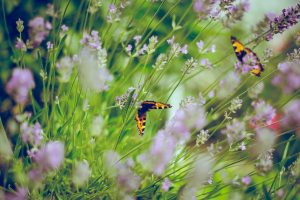Arborvitae are among the most popular trees to plant for Utah gardeners due to their steady growth, tall heights for privacy, plus foliage which stays a lush green all year long.
However, they’re sensitive to drought, winter burn, vulnerable to deer, and aren’t well-suited to Utah’s often heavy clay or salty soils. And even if you do have the right soil and water conditions for these stately plants, they still will need extra tender-loving care if you want to feature these lovely conifers in your garden.
In this article, join Glover Nursery as we tackle everything you’ll need to know about arborvitae fall care.
Arborvitae Fall Planting Tips
Note: This section is intended for first-time gardeners who are interested in planting arborvitae in the fall.
Although spring is often the traditional season for planting, fall planting helps arborvitae establish roots before the ground freezes. Cooler air reduces transplant stress, and soil warmth supports steady root development as the plants transition their energy from foliage growth to root growth. Both help prevent transplant shock.
First, choose a sunny site in your yard with good drainage. Arborvitae can struggle in heavy, compacted clay soil, a common challenge in Northern Utah.
After that, inspect your arborvitae’s root flare before planting. You need to remove any excess soil from the top of the rootball to expose the root flare prior to planting. Do not disturb the soil from the root structure itself. The root flare (top of the rootball) needs to be planted slightly above the garden soil line to avoid suffocating the plant.
We highly recommend soaking the root ball prior to planting. Pre-wetted roots help to reduce transplant shock, easing the transition to its new surroundings.
Next, dig a hole twice as wide as the root ball and the same depth as the rootball. Do not plant the root flare below ground; it will need to sit slightly above the surrounding soil line. Then backfill with 70% native soil (the soil you dug out of the ground to make room for the rootball) and 30% soil amendment. The type of soil amendment we most often recommend for arborvitae is Acid Planting Mix, but Soil Building Conditioner is also a great option. Mixing this amendment into the native soil has multiple advantages:
- Improves drainage, especially in clay soil, allowing water to flow past the roots, preventing root rot, while still holding moisture near the root system.
- It improves soil structure, allowing air flow throughout the area which roots do need between waterings.
- Mixing native soil with an appropriate amendment helps the roots acclimatize to native soil as they grow, which is beneficial as they transition into the “wall” of native soil.
A few helpful tips when planting to make your job easier (and the plant happier):
- After placing the rootball in the hole, correct any leaning by using a shovel carefully placed under the rootball, and lift the rootball and gently pack soil under the roots where needed to ensure the plant is centered from all directions. You want to use the rootball to adjust the plant, do not bend or push the branches as they could break and the plant will still not be centered. For visual guidance on this, please check out this video:
- Place a hose at the bottom of the hole while you are backfilling the soil mix around the rootball. Turn the hose on to a gentle flow and let it fill to the top of the backfilled hole. Then, turn off the water and let the water drain and settle the loose soil. This process will eliminate unnecessarily large air pockets, which helps to keep the plant centered and growing upright. If large pockets appear after settling the soil, add more of the soil mix to ensure an even placement of soil and then fill once more with water to settle the soil again.
- DO NOT stomp on the soil to settle it down. This will break roots and could lead to severe damage or even death of the plant.
If you’re planning to create a hedge row, space arborvitae at least 3 feet apart when planting. Crowding can create poor airflow and nutrient competition. Green Giant Arborvitae are a popular option since they grow faster and have better stress tolerance than the more delicate, smaller varieties.
Arborvitae Fall Watering Tips
Arborvitae are not drought-tolerant shrubs, so consistent deep watering throughout
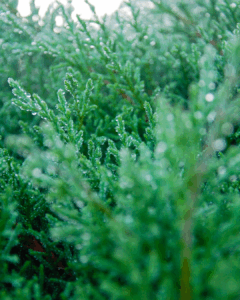 the year, including winter months, is critical for survival in Northern Utah’s dry and windy climate. And yes, this even includes watering in the fall and winter months! This also means sprinkler irrigation is not enough for arborvitae. Hand watering, drip systems, or soaker hoses provide the slow, steady soaking needed to properly saturate their roots.
the year, including winter months, is critical for survival in Northern Utah’s dry and windy climate. And yes, this even includes watering in the fall and winter months! This also means sprinkler irrigation is not enough for arborvitae. Hand watering, drip systems, or soaker hoses provide the slow, steady soaking needed to properly saturate their roots.But you might be wondering, “How often to water arborvitae in the fall?” Good question!
Newly planted arborvitae need deep soaking every 1-2 days during warm or dry spells. Established trees require weekly deep watering. As the ground doesn’t usually freeze completely until January, sometimes even February, be prepared to water your arborvitae consistently throughout the winter months. Learn more about our suggested winter watering protocols.
Dry soil means it is time to water again to protect the root systems. This is done because hydrated roots prevent winter burn, which is caused by moisture loss from Northern Utah’s cold and dry winds. Dry roots greatly increase the risk of browning as, even though plants may be dormant, the evergreen needles will still transpire. This means the needles will pull water from the soil up through the foliage. If there is not any water for this process, the needles will dry out and turn brown. Drying out over the winter is a common cause of decline for arborvitae that is further compounded by warming temperatures in spring months.
Note: Avoid overhead watering because it wets the foliage. During cooler nights, wet foliage encourages fungal problems such as tip blight or leaf spot to fester and spread.
In very dry winters, water monthly on warmer days. Established arborvitae still need moisture even when temperatures stay below freezing for extended periods.
The type of water also matters when watering your arborvitae. These shrubs succeed only when irrigated with culinary water (drinking water grade). Untreated or secondary water is often too salty and alkaline, which eventually kills the arborvitae through soil mineral imbalance.
If your yard has clay soil or uses secondary water, consider planting junipers or yews instead. These conifers tolerate difficult Utah conditions far better than arborvitae.
Arborvitae Fall Pruning Tips
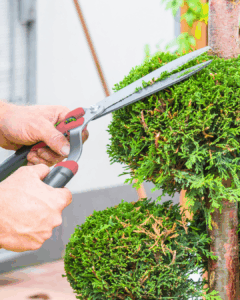
Pruning is optional in arborvitae fall care. But when you do, we recommend pruning arborvitae lightly in very late winter or early spring. Pruning during the cooler fall or early winter seasons can promote new growth, which will be very tender and therefore more easily damaged by Northern Utah winter conditions.
When pruning, always remove damaged, diseased, or broken branches first. This preserves the arborvitae’s energy for healthy growth and keeps it resilient through winter. Here are some more pruning tips you can follow:
- Avoid cutting back into old wood. Arborvitae cannot regrow foliage from bare stems, which could leave permanent gaps from aggressive pruning.
- If maintaining hedges, prune twice yearly. We highly recommend doing the heavy shaping in late spring, while light shaping can be done in early fall.
- Do not remove more than ¼ of the crown in any season. Over-pruning weakens arborvitae and reduces their ability to survive winter.
Note: Arborvitae naturally shed their interior foliage in fall. Browning needles inside the canopy are part of this process and not a sign of disease.
However, fungal spores can overwinter in fallen plant material. Clear the needles that have fallen as well as any other debris at the base of the plant. This lowers the risk of disease development the following spring.
Tip blight may also mimic natural shedding. If browning occurs on branch tips rather than inner needles, adjust watering practices to avoid prolonged wet foliage.
Can You Fertilize Arborvitae in the Fall?
Yes, though the recommended fertilizer will change depending on how long the arborvitae has been planted.
- During the first growing season, we recommend using Fertilome Root Stimulator
- In the second growing season, use Ferti-Lome Acid Loving Plant Food.
- In the third season (and beyond), use Ferti-Lome Tree and Shrub Food, or any balanced all-purpose fertilizer with an acidifier product like sulfur, gypsum, etc.
Additionally, a healthy layer of fresh compost is always beneficial for arborvitae in Northern Utah. It improves soil structure, enhances drainage, and supports beneficial soil microbes that help roots absorb nutrients more efficiently.
If you’re caring for newly planted arborvitae, we recommend using mild root stimulators in the fall. These strengthen root systems without pushing vulnerable top growth.
We don’t recommend quick-release fertilizers in arborvitae fall care. These push tender new growth that is easily destroyed by early frosts in Utah’s high-altitude climate. If you prefer fertilizer, choose a slow-release product for fall application.
Always follow label instructions. Overfertilizing may cause salts to accumulate in dry Utah soils, which burns roots, scorches foliage, and reduces overall vigor.
With this in mind, the Glover Nursery team particularly recommends Ferti-Lome Root Stimulator. It contains indole-3 butyric acid, an ingredient proven to encourage early root development in young trees and shrubs like arborvitae.
Mulching Arborvitae in Fall
Mulching has many purposes in Utah gardens, like weed suppression, soil
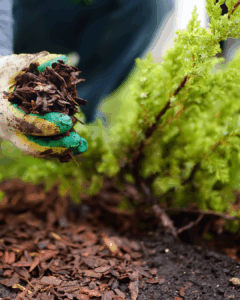
enrichment, and temperature regulation. For all plants, including arborvitae, organic bark mulch adds a layer of insulation around the roots. Mulch also helps to conserve soil moisture, which is lost quickly to canyon winds.
With this in mind, apply mulch 3-4 inches deep around the base in a wide circle. Bark chips and compost work best to insulate soil, regulate moisture, and slowly improve soil quality.
Also, keep the mulch pulled back a few inches from the trunk. Direct contact of mulch built up around trunks can create conditions that harbor disease, encourage pests, or create crown rot.
Refresh mulch each fall before the first freeze. As mulch will break down over time, replenishing is necessary to keep your soil healthy for a happy and healthy plant.
Deer Arborvitae Care Guide
Deer are problematic when it comes to arborvitae fall care. These conifers are a delicious snack for them, and they can easily strip the bottom 4-5 ft of your hedge bare.
To remedy this, you can try companion planting and include strongly scented herbs like lavender or rosemary near the arborvitae. These scents help reduce browsing pressure and make the area less inviting.
This helps, but deer adapt quickly to scents, and their taste preferences vary. For this reason, fencing remains the most reliable long-term option.
The state’s wildlife resources recommend putting up a fence at least 7.6 feet tall. You may need to go even higher, since deer can jump that high. The fence must also extend down to the soil line, as hungry deer will dig underneath if they find a gap.
However, putting up a tall fence is expensive and may not be a priority for gardeners not heavily invested in deer resistance. There are some deer resistant temporary fencing options that can be useful around individual plants, which would reduce the cost.
Alternatively, wrapping the arborvitae (which we recommend for winter) will reduce the available branches for deer to munch on. Though as we always say, a hungry deer will find a way to nibble through if it doesn’t have another option for food available nearby.
Winterizing Your Arborvitae
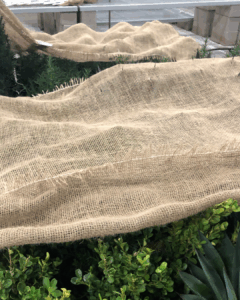
Winterizing your arborvitae boils down to two things: protecting it from Northern Utah’s harsh winds and mitigating winter burn. Here’s how you can achieve a good winterizing routine:
- Water deeply before the ground freezes. Well-hydrated roots endure winter stress more effectively than dry ones. Anti-transpirant products like Wilt-Pruf help reduce water loss from foliage.
- Tie arborvitae tops loosely with soft twine before storms. This prevents branches from splitting under ice, which is more damaging than Utah’s typically light, powdery snow.
For this reason, burlap is going to be one of your best friends in arborvitae fall care. You can wrap the branches with burlap strips for extra support and stability. The burlap also helps hold limbs upright and shields against strong canyon winds. - Burlap also works as an effective windbreak on the windward side if fencing is not available. A barrier like this is often enough to stop severe browning.
- When winter comes around, continue watering monthly during the dry spells. Arborvitae require consistent moisture even when dormant, especially in Northern Utah’s arid winters.
If winter browning still occurs, wait until spring to prune. Remove damaged tips only after new growth appears, confirming which branches are truly dead.
Take Better Care of Your Arborvitae With Glover Nursery
This guide covers everything you need to know about arborvitae fall care. Gardening essentials like the mulch, fertilizer, and anti-transpirant can all be purchased at our physical store. We encourage you to stop by if you plan on adding arborvitae to your garden soon!
We also have a more well-rounded guide for year-round arborvitae care you can peruse on our website.
If you encounter a problem that’s outside the scope of this guide, the Glover Nursery Diagnostic Team is happy to help you. Simply fill out our Plant Diagnosis form, and we’ll find a solution to your issue. Free of charge.
As always, happy gardening!
